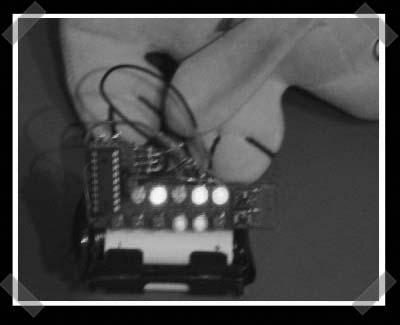
[Walter] sent in his version of a PIC binary clock. It’s a nice alternative If you don’t want one that runs off TTL logic, This one runs on a PIC 16F628 (Microchip is great for samples) and displays hours in 5 bits and minutes in 6. His blog also features a decent looking programmer, and he shows off his version of the Suunto dive computer interface that’s been around for quite a while.
18 thoughts on “Binary Clock”
Leave a Reply
Please be kind and respectful to help make the comments section excellent. (Comment Policy)















first post again w00t
enough with the binary clocks. as hack-o-riffic as it is… it’s old. death to all binary clocks.
010100110110111101101101011001010110111101101110011001010010000001100111011011110111010000100000011101010111000000100000011011110110111000100000011101000110100001100101001000000111011101110010011011110110111001100111001000000111001101101001011001000110010100100000011011110110011000100000011101000110100001100101001000000110001001100101011001000010000001110100011010000110100101110011001000000110110101101111011100100110111001101001011011100110011100101110
the ‘628 is overkill for this project; save money and use a smaller pic!
@nickjohnson: agreed about the 628 in terms of cost; however, as our ever helpful mr. o’brien mentioned, you can get them in samples from parts suppliers. samples, i.e. free, including shipping, often in quantities >= 10! what’s better than free? …if you’ve not tried this, i highly, highly suggest this route for any hobbyist.
heh, my buddy did the same 2 days ago.
Slow day on Hackaday, eh?
I would like to look as it it your friend has made
no offense to the project, but binary clocks are kind of old hat. it wouldn’t be any more technically adavnced, but i’d be more impressed with a less common numbering system like octal or some convoluted system like base 3 or 5…
Good show ed3
I like the analog binary clocks they showed somewhere in there… I may just have to build one!
I put the schematic online too.It costs (including 16f628 or 627 is also good) about 7 dollars in parts including 628.It is different from the commercial binary clocks (and thus original):16h23will be shown as10000 010111Whereas on the commercial binclocks it is shown as00001 01010 00010 00011The commercial ones only teach you binary numbers from 0 to 9.This one teaches you binary numbers from 0 to 59
This could easly be done for the Hackaday design challange…
“analog binary clocks”…. almost sounds like an oxymoron! ;)
I might actually do this one, or a modification of it. I’ve always wanted a binary clock that reads the time in true binary, (ie first bit representing am/pm, second bit representing after or before 6, third bit after/ or before 3, and so on… 8 LEDs would get you down to around 5 minutes accuracy, plenty enough for my purposes.Has anyone else ever though of time as a binary concept rather than the arbitrary 24x60x60?A single byte could represent that ~5 minute accurate time unit. We could call it a binute. :)
I don’t mind if they show a different binary clock a day. It’s still ingenuity. If you don’t like it, why not build something better? I bet most of the people criticizing can’t even follow directions to make one if they had someone hold their hand the entire process.
01101000011101010111001101101000001000000110000101100010011011110111010101110100001000000111010001101000011001010010000001110011011000010110110101110000011011000110010101110011
Does anyone know where I can get the hex for this clock. I am kinda new to pics and I only know how to program a hex file to the chips.